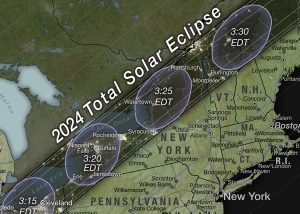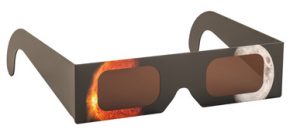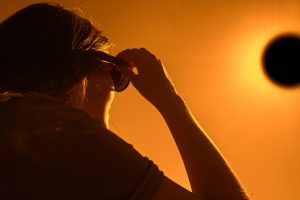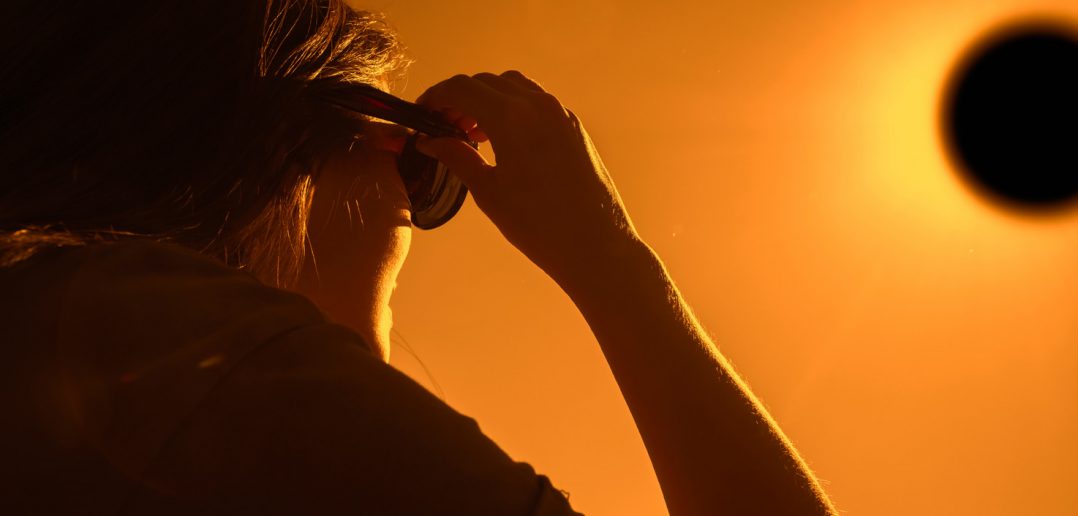
(Image provided by NASA.)
For many New Yorkers, the April 8 solar eclipse that will cross the state will be the experience of a lifetime.
The solar eclipse’s path will allow those in parts of Western, Central and Northern New York to see a “total” solar eclipse, where the sun’s rays will be blocked by the moon completely and the bright daytime will darken as if it were dawn or dusk for about 3.5 minutes.
In New York, the eclipse will begin in Chautauqua County around 2 p.m. and will move northeast; the path of totality includes the cities of Jamestown, Buffalo, Rochester, Syracuse and Plattsburgh. All other areas of New York that are not in the path of totality will have least an 85% eclipse of the sun by the moon.
The eclipse is considered a once in a lifetime experience because a total solar eclipse occurs in the same place only once every 400 years. No areas of New York state will see a total eclipse again until 2079.
While the eclipse is exciting for many New Yorkers, it is also important to ensure safety for anyone who may be outdoors during the event, including CSEA members who are on the job or commuting during that time.
Looking at the sun to view an eclipse can cause severe retina injuries, which is why experts are recommending that you view the sun through special-purpose solar filters such as eclipse glasses or handheld viewers.
The eclipse is also expected to lead to heavy traffic volume, particularly in the areas that will have totality. State and local officials are recommending ways to stay safe.
CSEA members who may be working outdoors or traveling during the eclipse should ensure their employer provides training, personal protective equipment and work procedures to help reduce the potential hazards.
Here are guidelines for members who are working outdoors or traveling. Please remember that if you are on the job, your employer must provide you with protective equipment.
 View the sun through eclipse glasses or a handheld solar viewer during the partial eclipse phases. Safe solar viewers need to comply with the ISO 12312-2 international standard.
View the sun through eclipse glasses or a handheld solar viewer during the partial eclipse phases. Safe solar viewers need to comply with the ISO 12312-2 international standard.- Do NOT look at the sun through a camera lens, telescope, binoculars, or any other optical device while wearing eclipse glasses or using a handheld solar viewer.
- Do NOT use eclipse glasses or handheld viewers with cameras, binoculars, or telescopes. Those require different types of solar filters.
- You can view the eclipse directly without proper eye protection only during the brief period of totality.
- You should NOT use adjustable and/or auto-darkening welding helmets or similar products to view the sun.
- Even during the partial phases of a total eclipse, the sun will still be very bright. If you are watching an entire eclipse, you may be in direct sunlight for hours. Remember to wear sunscreen, a hat, and protective clothing to prevent skin damage.
- If you are involved in parking or traffic control, use your high-visibility clothing and traffic control devices to stay safe.
 More resources:
More resources:
For information on eclipse safety and how to make an indirect viewer, visit https://science.nasa.gov/eclipses/safety/
For more on solar viewing safety, visit https://eclipse.aas.org/eye-safety and safe solar viewers and filters at https://eclipse.aas.org/eye-safety/viewers-filters.
For an interactive viewing map to see eclipse times, peak sun coverage and likely levels of cloudiness during the eclipse, visit https://data.democratandchronicle.com/2024-total-solar-eclipse.
To learn more, visit cseany.org/solar-eclipse-safety


